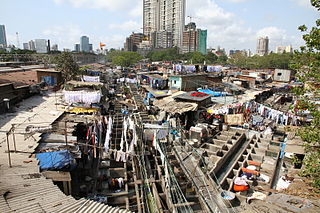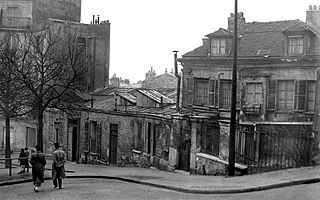
The Bateau-Lavoir is the nickname of a building in the Montmartre district of the 18th arrondissement of Paris that is famous in art history as the residence and meeting place for a group of outstanding early 20th-century artists, men of letters, theatre people, and art dealers. It is located at No. 13 Rue Ravignan at Place Emile Goudeau, just below the Place du Tertre.
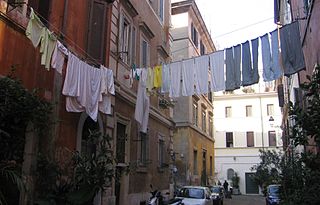
Laundry refers to the washing of clothing and other textiles, and, more broadly, their drying and ironing as well. Laundry has been part of history since humans began to wear clothes, so the methods by which different cultures have dealt with this universal human need are of interest to several branches of scholarship.
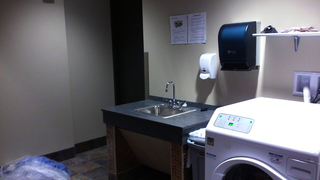
A laundry room is a room where clothes are washed and dried. In a modern home, a laundry room would be equipped with an automatic washing machine and clothes dryer, and often a large basin, called a laundry tub, for hand-washing delicate articles of clothing such as sweaters, and an ironing board. A typical laundry room is located in the basement of older homes, but in many modern homes, the laundry room might be found on the main floor near the kitchen or upstairs near the bedrooms.

Ghat, a term used in the Indian subcontinent, refer to the series of steps leading down to a body of water or wharf, such as a bathing or cremation place along the banks of a river or pond, the Ghats in Varanasi, Dhobi Ghat or the Aapravasi Ghat.
Linens are fabric household goods intended for daily use, such as bedding, tablecloths, and towels. "Linens" may also refer to church linens, meaning the altar cloths used in church.

Auxey-Duresses is a commune in the Côte-d'Or department in the Bourgogne-Franche-Comté region of eastern France.

Quistinic is a commune in the Morbihan department of Brittany in north-western France. Its sister city is the rural village of Loughshinny, which is in County Dublin, Ireland.

Aubigny-la-Ronce is a commune in the Côte-d'Or department in the Bourgogne-Franche-Comté region of eastern France.
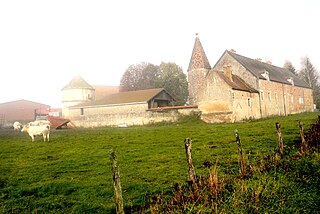
Argilly is a commune in the Côte-d'Or department in the Bourgogne-Franche-Comté region of eastern France.
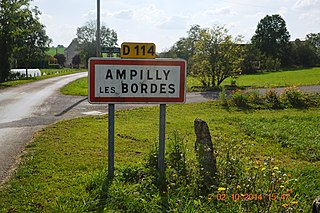
Ampilly-les-Bordes is a commune in the Côte-d'Or department in the Bourgogne-Franche-Comté region of eastern France.
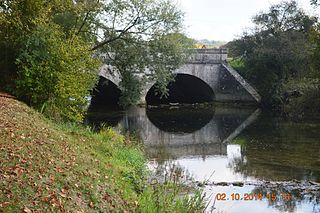
Aisey-sur-Seine is a commune in the Côte-d'Or department in the Bourgogne-Franche-Comté region of eastern France.

Aignay-le-Duc is a commune in the Côte-d'Or department in the Bourgogne-Franche-Comté region of eastern France.

A washerwoman or laundress is a woman who takes in laundry. Both terms are now old-fashioned; equivalent work nowadays is done by a laundry worker in large commercial premises, or a laundrette (laundromat) attendant.

Angles is a commune in the Alpes-de-Haute-Provence department in the Provence-Alpes-Côte d'Azur region of southeastern France.

Bonnat is a commune in the Creuse department in the Nouvelle-Aquitaine region in France.

Barbirey-sur-Ouche is a commune in the Côte-d'Or department in the Bourgogne-Franche-Comté region of eastern France.

The washing paddle, known as thaapi in Haryanvi and Hindi languages, is a hand tool used to do laundry. It is made of wood, shaped like a baker's peel, but with a much shorter handle used as a grip. It was used to beat the wet clothes and linens, pushing out the dirt by hammering the items against the washboard, or against the flat slabs built into the laundry area.
Dhobi ghat or dhobighaat is used throughout south-central Asia to refer to any laundry-place or washing-place where many launderers or clothes-washers are present; they may be ordinary people or professionals who use the place to wash clothes and other linen. Mumbai has an extensive dhobi ghat known as Mahalaxmi Dhobi Ghat and there are several other dhobi ghats in Mumbai.


























